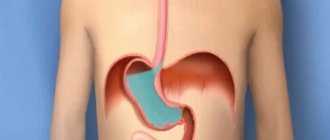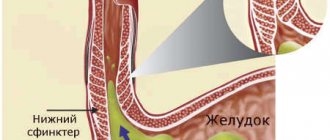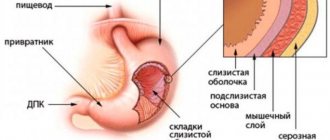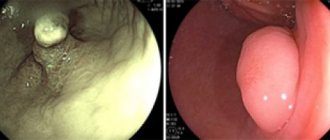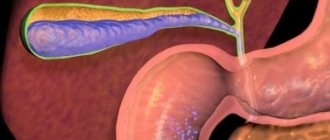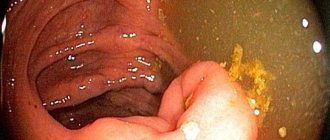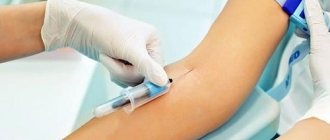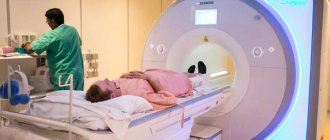- September 23, 2018
- Gastroenterology
- Evdokimova Irina
The human digestive system is a complex multifunctional device. The work of all organs of the gastrointestinal tract is harmonious and interconnected. Disruption of the functioning of one of the sections of digestion causes disruptions in the entire system. Many gastric diseases are not associated with either infection or tumor; these pathologies are caused exclusively by functional abnormalities. One of these ailments is cardia insufficiency; what it is will be discussed further.
What is cardia?
The digestive tract contains circular muscles that act like valves. They help food move through the esophagus, stomach and intestines. Such muscles are called sphincters, they are able to contract when necessary and close the passage.
The cardia of the stomach is one of these muscles. It is located between the stomach and esophagus and regulates the flow of food. The sphincter is closed when a person is not eating and opens when eating so that food can enter the stomach. This happens during normal muscle functioning. The cardia prevents food and gastric juice from flowing back into the esophagus.
But sometimes the sphincter malfunctions, and then gastroenterologists diagnose “cardia insufficiency.” What it is? The pathology is that the muscle stops contracting or does not close completely, and food, along with gastric juice, is thrown into the esophagus. In medicine this is called reflux. This phenomenon can also occur in completely healthy people. But during normal functioning of the body, the esophagus is protected, the mucous membrane is quickly restored, and inflammation does not occur.
But if the protection of the esophagus is reduced, then the reflux of acid and food leads to burns and inflammation of the mucous membrane. This disease is called reflux esophagitis, and it requires immediate treatment. In advanced cases, ulcerations appear on the lower part of the esophagus.
Externally, the cardia resembles a round rosette. In a healthy body it closes in a circle. With its pathology, gastroenterologists talk about insufficiency of the cardia rosette.
Main symptoms of the disease
If a person is suspected of insufficiency of the gastric cardia, symptoms may be as follows:
- Heartburn. The appearance of heartburn is not associated with food intake, that is, it occurs regardless of whether a person has eaten or not. Sometimes an attack of heartburn can be so severe that it deprives a person of peace.
- Pain in the stomach area. The intensity of pain can vary - from dull pain to a strong, intense burning sensation in the esophagus.
- Belching of air and stomach contents. Belching usually has a characteristic sour taste. If there is bile in the contents of the stomach, then the belching will have a bitter taste.
- Nausea. As the intensity of nausea increases, vomiting joins it.
- Pain in the epigastric region and rumbling sensations in the stomach arise from stretching of the esophageal mucosa and irritation by the acids contained in the gastric juice.
- Dizziness and general weakness are fickle companions of gastric cardia insufficiency. Their appearance is associated with general disorders of the digestive tract.
- With distal reflux, a whitish coating appears on the tongue. This symptom is also accompanied by burning pain in the hypochondrium and a feeling of “transfusion” in the abdominal area. If a person develops gastroesophageal disease, the patient usually washes his food down with water. Smokers may want to pay attention to the fact that they wash down their cigarette with water. With a severe degree of esophagitis, problems with swallowing appear - precisely because the esophagus narrows slightly.
Causes of pathology
Cardia failure with reflux esophagitis occurs due to not one, but several reasons. Factors that provoke sphincter weakness are divided into organic and functional. Organic causes are not related to the activity of the cardia rosette, but are caused by the fact that the sphincter has to work in unfavorable conditions. Such reasons include:
- excessive eating;
- excess body weight;
- systematic overeating in the evening;
- low mobility;
- chronic stomach diseases (ulcers, gastritis);
- lower esophageal hernia.
Functional reasons are associated with disruption of the sphincter muscle ring itself. These factors include:
- accumulation of fluid in the abdominal cavity (ascites);
- pregnancy;
- age over 35 years;
- physical stress during work or sports;
- intra-abdominal hypertension;
- unsuccessful operations on the gastrointestinal tract;
- pyloric spasm.
Causes
Cardia deficiency can occur in anyone. No one is immune from cardiac sphincter. Pyloric dysfunction can occur at any age, and it is sometimes difficult to determine what caused it. In addition, the occurrence is often associated with causes that cannot be prevented. However, most often the development of this disease is directly related to lifestyle. However, the most common factors that can cause the sphincter to not close are:
- smoking;
- alcohol abuse;
- high salt intake;
- low dietary fiber intake;
- passive lifestyle;
- irregular meals;
- overweight;
- eating heavy meals while lying on your back or bending at the waist;
- snacks before bed;
- frequent stress;
- side effect from taking certain medications;
- Sometimes cardiac sphincter can occur during pregnancy.
Stages of the disease
There are several degrees of gastric cardia insufficiency. What it is? Depending on how much the sphincter loses its ability to close, there are 3 stages of the disease:
- Stage 1. Incomplete closure of the cardia rosette occurs. Patients complain of frequent belching. During endoscopic examination, a small gap (about 1/3 of the diameter) can be seen in the cardia when the patient breathes deeply.
- Stage 2. With deep breathing, the gap increases to 1/2 the diameter. The patient complains of nausea and a feeling of heaviness in the digestive organs.
- Stage 3. The sphincter completely stops closing. If the patient suffers from liver pathologies, this aggravates the development of cardia failure. Symptoms of esophagitis (inflammation of the esophagus) become pronounced.
In the photo you can see endoscopic changes in the cardia with insufficiency: gaping gaps and inflamed areas.
Signs of disease development
The level of development of the pathology is diagnosed endoscopically. There are several degrees of development of the disease.
- First degree. The mobile cardia does not close completely. In this case, the open gap should not be more than 1/3 of the total diameter during deep breathing. Among the external manifestations are frequent belching of air.
- Second degree. The cardiac sphincter closes only halfway. The gaping may even be slightly excessive. Belching becomes painful and very frequent. Sometimes prolapse of the gastric mucosa develops.
- Third degree. The cardiac sphincter does not close at all. There are signs of esophagitis.
Read: Symptoms of indigestion or why digestion does not work
The main symptoms of mild cardia include the following:
- heartburn that appears at different times relative to food intake;
- burning pain that spreads behind the sternum, where the esophagus passes;
- frequent belching with air, as well as with what is in the stomach (if the belching is sour, it means that it contains only the contents of the stomach, if there is a bitter taste, it means that bile has been added);
- nausea, which often ends with vomiting;
- esophagitis, which appears due to irritation of the mucous membrane, gives abdominal pain, and there is murmur in the intestines;
- weakness, dizziness, fatigue.
Symptoms of cardia failure
It is difficult for a patient to determine on his own that he suffers from cardiac insufficiency. The symptoms of this disease are similar to those of many other stomach ailments. The following manifestations should be the reason for contacting a gastroenterologist:
- bitterness in the mouth;
- admixture of bile in vomit;
- belching with a sour taste;
- pain in the stomach and esophagus;
- dizziness, weakness, loss of appetite;
- frequent heartburn;
- burning sensation behind the sternum;
- nausea;
- rumbling in the stomach;
- a feeling of spasms in the area where the esophagus enters the stomach.
With cardia insufficiency, superficial gastritis is a common occurrence. These two diseases often accompany each other. Inflammation of the stomach can cause sphincter weakness. In this case, there is pain behind the sternum, constant rumbling in the abdomen, general weakness, the tongue is coated with a white coating. Superficial gastritis can be provoked not only by poor nutrition, but also by wearing tight clothing that squeezes the waist.
Gastroesophageal reflux disease is a common complication of cardia failure. What it is? The disease develops due to chronic reflux of stomach contents into the esophagus. Severe pain occurs in the chest, which patients sometimes mistake for myocardial infarction. Symptoms from the stomach are accompanied by signs of damage to the upper respiratory tract: sore throat, hoarseness, difficulty swallowing.
The most dangerous complication of cardia insufficiency can be malignant degeneration of the cells of the esophageal mucosa. The aggressive effects of hydrochloric acid negatively affect the condition of the epithelium and over time can provoke the growth of tumors.
Reasons for the development of the disease
Cardiac sphincter insufficiency is quite common
The disease can appear as a result of a wide variety of factors:
- unhealthy diet, overeating;
- obesity;
- diseases of the stomach, in particular gastritis, ulcers, tumors, hypertonicity of the stomach muscles);
- eating before bed;
- low mobility;
- hiatal hernias;
- pyloric spasm;
- increased intra-abdominal pressure that appears during pregnancy, ascites;
- increased pressure in the stomach;
- operations accompanied by sphincter resection.
Intra-abdominal pressure can develop as a result of heavy physical labor and heavy loads. From overwork, hiatal hernias appear. This can also provoke pathology.
Diagnosis of cardia failure
The disease is diagnosed based on the results of an X-ray of the stomach. Esophagoscopy will help determine the stage of the disease. The methylene blue test determines the presence of reflux esophagitis in cardiac insufficiency. What it is? During an endoscopic examination, a dye is injected into the patient's stomach. The substance colors only healthy areas; inflamed areas do not change color.
In addition, additional studies are prescribed:
- stomach acid test;
- ultrasound examination of the abdominal organs;
- fibrogastroduodenoscopy.
Based on all the studies, the doctor makes a diagnosis of “cardia insufficiency.” How to treat this pathology depends on the cause and stage of the disease.
Physiotherapy
The muscular structures of the gastric cardia can be easily strengthened. For this purpose, specially designed breathing exercises are used. Particularly popular is Strelnikova’s gymnastic method, which involves performing training twice during the day: in the morning and in the evening before a meal, and also after an hour and a half after its end, for 1500 breaths.
As a preventive measure, gymnastics is performed in the morning or evening period. Such breathing exercises help strengthen the body and improve the health of internal organs due to increased blood flow.
Regular breathing exercises for insufficiency of the gastric cardia will be no less useful:
- The training should be carried out on an empty stomach, since any activity performed on a full digestive organ weakens the sphincter, which is explained by the pressure of gastric contents on the valve.
- The lungs are perhaps the only organ that can be controlled externally. For this reason, you need to start gymnastics with normal inhalations and exhalations.
- Exercises should be performed simultaneously with thoracic and abdominal breathing, when the muscular structures of the abdominal cavity become involved in the respiratory process.
- Inhalations and exhalations must be carried out in compliance with different speed limits.
If the disease occurs in the final stages, then the listed gymnastic exercises become useless.
Drug treatment
Cardia failure is a chronic disease. It is difficult to cure it completely. But it is possible to reduce the relapse rate.
First of all, you need to eliminate the cause of sphincter weakness. If you are overweight, then diet and exercise are necessary to reduce body weight. Lifestyle changes are required: proper nutrition, refusal to wear tight clothes. It is recommended to sleep with your head elevated. Excessive physical exertion and sudden bending of the body should be avoided.
Drug treatment is aimed at strengthening the sphincter and relieving pain attacks. The following drugs are prescribed:
- means for increasing motility and tone of the digestive organs: “Metamol”, “Motilium”, “Propulsid”, “Raglan”, “Perinorm”, “Metoclopramide”;
- painkillers: “Ibuprofen”, “Tempalgin”;
- medications that coat the gastrointestinal mucosa: “Almagel”;
- Heartburn relievers: Ranitidine, Smecta.
Diet for cardia deficiency
If the sphincter is weak, split meals are useful. You need to eat often, but in small portions. If you eat too much food at one time, the rosette of the cardia will stop closing. The following nutritional principles must be observed:
- After eating, you cannot lie down for 2 hours, you can only walk or stand.
- You should eat food in semi-liquid form: porridge, low-fat broths.
- You can't overeat in the evening.
- You need to exclude chocolate, spicy, fried and fatty foods. Excessive amounts of salt and coffee can also aggravate symptoms of the disease.
- The consumption of alcohol and carbonated drinks is strictly prohibited.
- During each meal, you do not need to fully load your stomach.
- Food should not be too hot or too cold.
Treatment of gastric cardia incompetence
Of course, receiving treatment via the Internet is inadmissible in any case, and the doctor will prescribe therapy on an individual basis. However, there are a number of recommendations that people diagnosed with cardiac sphincter insufficiency must follow.
First of all, this is the establishment of a daily routine and a special diet. It is strictly forbidden to eat too much, eat too salty, pickled, spicy and fatty foods. A complete ban is imposed on alcohol, citrus fruits, and chocolate. Patients should eat four to five small meals a day that provide a slight feeling of fullness. After a person has eaten, a horizontal position should be avoided for one and a half to two hours - you can walk or, at most, sit down. No later than three to four hours before going to bed, you need to exclude all kinds of food.
In the treatment of cardiac sphincter insufficiency, not only pills help, but also a properly organized nutritional regimen
In general, the diet is based on boiled or steamed dishes with a small amount of salt. To reduce gastric acidity, “enveloping” foods such as jelly and porridge are included in the diet. It is worth making sure that food is chewed slowly and thoroughly; eating pureed foods and first courses is encouraged. Avoid eating too cold or hot dishes - food should be warm.
An important point is that during treatment you need to say goodbye to such a bad habit as smoking. In addition to the main harm from cigarettes, they also provoke the powerful production of digestive enzymes. Simply put, when a person smokes a cigarette, the gastrointestinal tract believes that he has eaten and begins the digestive process, but in fact, the stomach digests itself.
During the treatment process, doctors also prohibit all physical work, and especially overload. This also applies to the emotional state of patients - they are strongly advised not to be nervous. Sometimes a gastroenterologist works in tandem with a physical therapist and the patient is prescribed gentle exercises. They are designed to restore the tone and muscles of the cardiac sphincter, and at the same time strengthen the diaphragm, abdominal and abdominal muscles, lumbar spine and other muscles. Often, breathing exercises and elements of yoga are used to support the body during treatment. But you should understand that even harmless exercises are strictly prohibited without a doctor’s recommendation.
Breathing exercises
There are also a number of specific restrictions:
- Avoiding tight clothing, belts, elastic bands, etc.
- The lying position should be taken so that the head is slightly elevated.
- Frequent tilting of the head and body must be controlled and avoided.
- Work and interaction with chemicals must be stopped, and it is recommended not to return to it even after treatment.
Of course, mandatory treatment also includes taking medications.
Doctors usually prescribe a set of drugs:
- Antacids that relieve a burning sensation in the throat and heartburn.
- To restore and maintain the esophageal mucosa.
- Preventing stagnation in the stomach cavity, improving its motility.
- Antiemetic drugs.
- Specialized painkillers (pain can be caused by severe damage to the mucous membrane, right down to the muscle layer, so regular painkillers simply won’t cope).
- Antibiotics and antiprotozoal agents.
In cases where therapeutic treatment does not bring a positive effect, the patient is transferred from the gastroenterology department to surgery. Yes, insufficiency of the cardiac sphincter can be solved surgically: fundoplication, pyloroplasty, selective vagotomy. Of course, such serious issues are discussed with the attending physician, but we cite them as an example of the possible seriousness of the disease, which cannot simply be ignored.
Video - What is gastric cardia insufficiency
Surgical treatment of cardia failure
Surgical treatment is used in advanced cases. Sometimes surgical methods help get rid of the cause of cardia insufficiency, for example, a hernia.
To eliminate sphincter weakness, the following operations are performed:
- The wall of the esophagus is sutured to the stomach.
- Additional folds are surgically made in the esophagus.
- The muscles are sutured and the cardia ring is narrowed.
The surgeon decides which method to eliminate cardia insufficiency in each specific case.
Traditional methods of treatment
Therapy with home remedies can only be carried out as an addition to the main treatment. Before using traditional medicine, you should consult your doctor. When treating insufficiency of the esophageal cardia, the following traditional medicine recipes are used:
- Juice is squeezed out of plantain leaves and taken 1 teaspoon before meals during an exacerbation of the disease.
- A mixture of St. John's wort, motherwort and valerian herbs is brewed in equal proportions, filtered and taken with honey.
- Dandelion flowers are ground with sugar to form a syrup. Dissolve 1 teaspoon of the composition in a glass of water and drink before meals.
- Cumin (1 teaspoon) is brewed in a glass of boiling water and drunk before meals. This drink perfectly relieves spasms in the gastrointestinal tract.
We can conclude that cardia failure is accompanied by unpleasant symptoms. Such manifestations also occur in other gastrointestinal diseases. Therefore, you should not try to diagnose yourself. You need to contact a gastroenterologist as soon as possible for diagnosis and treatment.
Treatment
Non-closure of the cardia of the stomach requires complex treatment, which is selected according to the cause that provoked the disease. A scheme is often used that combines drug and dietary therapy in conjunction with traditional methods.
Drug treatment
- Antibacterial drugs that are relevant when identifying Helicobacter, which is the main cause of inflammation.
- Antisecretory agents are prescribed in case of increased acidity.
- Enveloping drugs provide protection to the gastric walls.
- Preparations containing enzymes necessary for better digestion of food.
Medication therapy can be symptomatic in nature when it is necessary to relieve the unpleasant manifestations of sphincter dysfunction. Then the following groups of drugs are prescribed:
- Antiemetics.
- Painkillers.
- Defoamers that suppress bloating and increased gas formation.
Folk remedies
To tone the cardiac sphincter, drinks containing caffeine are completely excluded from the diet. However, herbal infusions from medicinal plants valerian and St. John's wort are an alternative. Traditional medicine therapy is relevant only in the initial stages of the disease, when there are no complications, or during remission.
In the morning on an empty stomach, as well as before each meal, it is recommended to drink a glass of warm water.
In order to achieve a therapeutic effect, it is useful to use the following recommendations:
- Plantain juice helps normalize digestion.
- Between main meals, it is useful to drink an infusion made from calamus root. To do this, 5 grams of raw materials are poured into a glass of boiling water.
- Three times during the day, drink a medicinal infusion for the stomach, which is prepared from peppermint, plantain, St. John's wort, chamomile and yarrow.
- Dandelion flowers, which are covered with sugar and ground and then decanted, have a high therapeutic effect. The resulting syrup is diluted with water.
- Cumin is an indispensable remedy for restoring and maintaining proper functioning of the stomach. It can be consumed as a decoction or crushed and added to breakfast cereals.
